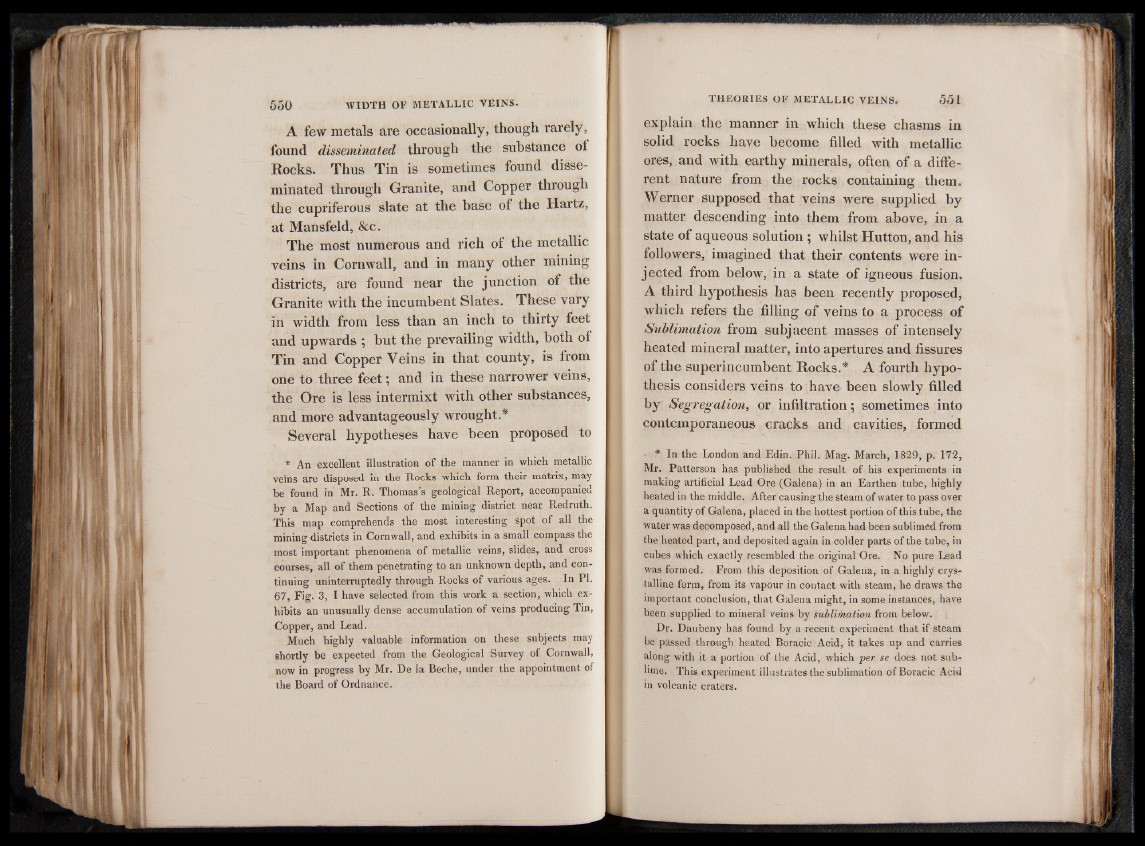
A few metals are occasionally, though rarely,
found disseminated through the substance of
Rocks. Thus Tin is sometimes found disseminated
through Granite, and Copper through
the cupriferous slate at the base of the Hartz,
at Mansfeld, &c.
The most numerous and rich of the metallic
veins in Cornwall, and in many other mining
districts, are found near the junction of the
Granite with the incumbent Slates. These vary
in width from less than an inch to thirty feet
and upwards ; hut the prevailing width, both of
Tin and Copper Veins in that county, is from
one to three feet; and in these narrower veins,
the Ore is less intermixt with other substances,
and more advantageously wrought.*
Several hypotheses have been proposed to
* An excellent illustration of the manner in which metallic
veins are disposed in the Rocks which form their matrix, may
be found in Mr. R. Thomas’s geological Report, accompanied
by a Map and Sections of the mining district near Redruth.
This map comprehends the most interesting spot of all the
mining districts in Cornwall, and exhibits in a small compass the
most important phenomena of metallic veins, slides, and cross
courses, all of them penetrating to an unknown depth, and continuing
uninterruptedly through Rocks of various ages. In PI.
67, Fig. 3, I have selected from this work a section, which exhibits
an unusually dense accumulation of veins producing Tin,
Copper, and Lead.
Much highly valuable information on these subjects may
shortly be expected from the Geological Survey of Cornwall,
now in progress by Mr. De la Beche, under the appointment of
the Board of Ordnance.
explain the manner in which these chasms in
solid rocks have become filled with metallic
ores, and with earthy minerals, often of a different
nature from the rocks containing them.
Werner supposed that veins were supplied by
matter descending into them from above, in a
state of aqueous solution ; whilst Hutton, and his
followers, imagined that their contents were injected
from below, in a state of igneous fusion.
A third hypothesis has been recently proposed,
which refers the filling of veins to a process of
Sublimation from subjacent masses of intensely
heated mineral matter, into apertures and fissures
of the superincumbent Rocks.* A fourth hypothesis
considers veins to have been slowly filled
by Segregation, or infiltration; sometimes into
contemporaneous cracks and cavities, formed
- * In the London and Edin. Phil. Mag. March, 1829, p. 172,
Mr. Patterson has published the result of his experiments in
making artificial Lead Ore (Galena) in an Earthen tube, highly
heated in the middle. After causing the steam of water to pass over
a quantity of Galena, placed in the hottest portion of this tube, the
water was decomposed, and all the Galena had been sublimed from
the heated part, and deposited again in colder parts of the tube, in
cubes which exactly resembled the original Ore. No pure Lead
was formed. From this deposition of Galena, in a highly crystalline
form, from its vapour in contact with steam, he draws the
important conclusion, that Galena might, in some instances, have
been supplied to mineral veins by sublimation from below.
Dr. Daubeny has found by a recent experiment that if steam
be passed through heated Boracic Acid, it takes up and carries
along with it a portion of the Acid, which per se does not sublime.
This experiment illustrates the sublimation of Boracic Acid
in volcanic craters.